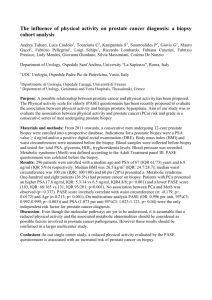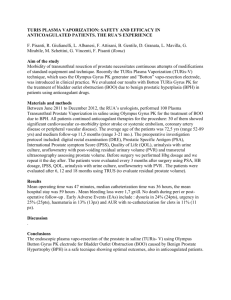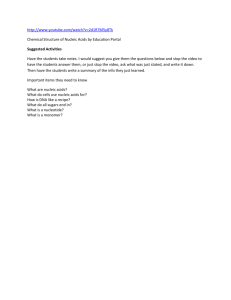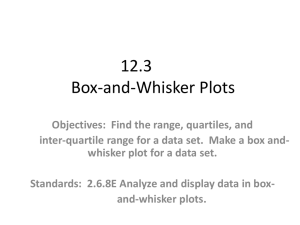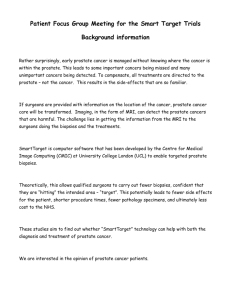Supplementary methods - Springer Static Content Server
advertisement
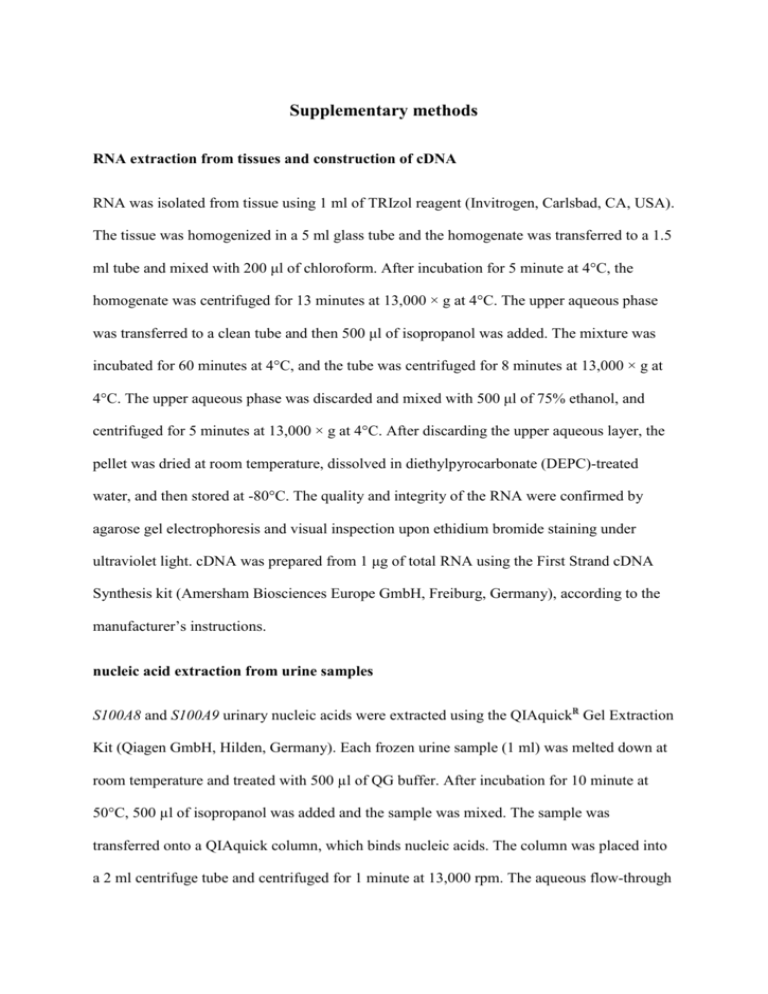
Supplementary methods RNA extraction from tissues and construction of cDNA RNA was isolated from tissue using 1 ml of TRIzol reagent (Invitrogen, Carlsbad, CA, USA). The tissue was homogenized in a 5 ml glass tube and the homogenate was transferred to a 1.5 ml tube and mixed with 200 μl of chloroform. After incubation for 5 minute at 4°C, the homogenate was centrifuged for 13 minutes at 13,000 × g at 4°C. The upper aqueous phase was transferred to a clean tube and then 500 μl of isopropanol was added. The mixture was incubated for 60 minutes at 4°C, and the tube was centrifuged for 8 minutes at 13,000 × g at 4°C. The upper aqueous phase was discarded and mixed with 500 μl of 75% ethanol, and centrifuged for 5 minutes at 13,000 × g at 4°C. After discarding the upper aqueous layer, the pellet was dried at room temperature, dissolved in diethylpyrocarbonate (DEPC)-treated water, and then stored at -80°C. The quality and integrity of the RNA were confirmed by agarose gel electrophoresis and visual inspection upon ethidium bromide staining under ultraviolet light. cDNA was prepared from 1 μg of total RNA using the First Strand cDNA Synthesis kit (Amersham Biosciences Europe GmbH, Freiburg, Germany), according to the manufacturer’s instructions. nucleic acid extraction from urine samples S100A8 and S100A9 urinary nucleic acids were extracted using the QIAquickR○ Gel Extraction Kit (Qiagen GmbH, Hilden, Germany). Each frozen urine sample (1 ml) was melted down at room temperature and treated with 500 µl of QG buffer. After incubation for 10 minute at 50°C, 500 µl of isopropanol was added and the sample was mixed. The sample was transferred onto a QIAquick column, which binds nucleic acids. The column was placed into a 2 ml centrifuge tube and centrifuged for 1 minute at 13,000 rpm. The aqueous flow-through was discarded and the QIAquick column was placed back into the same collection tube. Then, 500 µl of QG buffer was added to the QIAquick column and centrifuged for 1 minute at 13,000 rpm. The nucleic acids bound to the column were washed by centrifuging the column with 750 µl of PE buffer for 1 minute. The aqueous flow-through was discarded and the QIAquick column was centrifuged for an additional 1 minute at 13,000 rpm. The QIAquick column was placed into a clean 1.5 ml microcentrifuge tube. To elute the nucleic acids, 50 µl of EB buffer was added to the center of the QIAquick membrane and the column was centrifuged for 1 minute at 13,000 rpm. The nucleic acids dissolved in EB buffer were stored at -20°C until use. real-time PCR To quantify the expression of S100A8 and S100A9, real-time PCR was performed using a Rotor Gene 6000 instrument (Corbett Research, Mortlake, Australia). Real-time PCR assays were carried out in micro-reaction tubes (Corbett Research, Mortlake, Australia) using SYBR Premix EX Taq (TAKARA BIO INC., Otsu, Japan). The primers used for amplification of S100A8 (185 base pairs), S100A9 (151 base pairs) and GAPDH (156 base pairs) in the prostate tissues were as follows: sense, 5'-CATCGACGTCTACCACAAGT-3' and antisense, 5'-GAATGAGGAACTCCTGGAAG-3'; sense, 5'-CACCCAGACACCCTGAACCA-3' and antisense, 5'-CCTCGAAGCTCAGCTGCTTG-3'; and sense, 5'CATGTTCGTCATGGGTGTGA-3' and antisense, 5'-ATGGCATGGACTGTGGTCAT-3', respectively. The primers used for amplification of S100A8 (85 base pairs), S100A9 (90 base pairs) and GAPDH (83 base pairs) in urine were as follows: sense, 5'CATCGACGTCTACCACAAGT-3' and antisense, 5'-GGTCTCTAGCAATTTCTTCAG-3'; sense, 5'-CACGAGAAGATGCACGAGG-3' and antisense, 5'TTGGCCACTGTGGTCTTAGG-3'; and sense, 5'-ACCCAGAAGACTGTGGATGG-3' and antisense, 5'-GTAGAGGCAGGGATGATGTTC-3', respectively. The PCR products then were cloned into pGEM-T Easy vector (Promega, Wisconsin, USA) to make standard plasmid after confirming correct product by sanger sequencing. The standard plasmid was included in PCR run with S100A8/A9 in order to produce standard curve using copy number (with copy number of 105, 104, 103, 102, and 10) and threshold cycle (Ct) value. The Ct value of S100A8/A9 from the PCR run was plotted on the standard curve to calculate copy number. GAPDH was analyzed in parallel as an endogenous RNA reference gene and the expression of each gene of interest was normalized to that of GAPDH. All samples were run in triplicates. immunohistochemical staining Paraffin blocks from 19 prostate cancer cases and 20 BPH controls were used for immunohistochemical analysis. Tissue sections were cut, placed on Superfrost® Plus microscope slides (Fisher Scientific, Pittsburgh, PA) and stained using the Benchmark XT automated immunohistochemistry stainer (Ventana Medical Systems, Inc., Tucson, AZ). Detection was conducted using the Ventana Ultraview DAB Kit (Ventana Medical Systems). Sections were deparaffinized using the EZ Prep solution. CC1 standard (pH 8.4, buffer containing Tris/Borate/EDTA) was used for antigen retrieval. DAB inhibitor (3% H2O2, endogenous peroxidase) was blocked for 4 minute at 37°C. Sections were incubated with anti-S100A8 and -S100A9 primary antibodies (Abcam Inc., San Diego, CA) for 40 minutes at 37°C, and with a secondary antibody conjugated to Universal HRP Multimer for 8 minute at 37°C. Slides and then DAB with H2O2 substrate for 8 minutes followed by hematoxylin and bluing reagent counterstain at 37°C. Reaction buffer (pH 7.6 Tris buffer) was used as washing solution. The staining intensity and proportion of positively stained epithelial cells were evaluated. S100A8 and S100A9 were localized primarily to the cytoplasm. Staining intensity was classified as follows: none, weak, moderate or strong. Each specimen was examined and scored separately by three investigators, and discrepancies were discussed until agreement was reached. Supplementary Table 1. Clinicopathological characteristics and tissue S100A8/9 expression in CaP and BPH Characteristics Controls Cases No. 90 132 Age (years; range) 69.3 (46‒85) 69.6 (48‒87) 0.809 PSA ± SD (ng/ml) 4.61 ± 5.21 101.47 ± 254.32 < 0.001a Prostate size ± SD (gram) 38.42 ± 22.56 41.31 ± 23.32 60 (100) 63 (47.7) Operation (%) TURP Radical prostatectomy 69 (52.3) No. Gleason score (%) 6 or less 6 (4.5) 7 49 (37.1) 8 38 (28.8) 9 33 (25.0) P-value 0.411 10 6 (4.5) No. stage (%) Nonmetastatic 75 (56.8) Metastatic 57 (43.2) S100A8 expression, median (IQR; × 103 copies/μg)a S100A9 expression, median (IQR; × 103 copies/μg)a 240.6 (82.3‒1402.0) 4332.3 (147.2‒2058.9) 31.0 < 0.001b (8.8‒213.5) 110.1 < 0.001b (25.5‒523.3) Abbreviations: CaP, prostate cancer; BPH, benign prostatic hyperplasia; PSA, prostatespecific antigen; SD, standard deviation; TURP, transurethral resection of prostate; IQR, interquartile range. a Copy number of corresponding transcirpt per μg of total RNA used for cDNA synthesis b Mann-Whitney U test was used to compare the expression levels to clinical variables. Supplementary Table 2. Clinicopathological characteristics and S100A8/A9 urinary nucleic acid levels in CaP and BPH Characteristics Controls Cases No. 363 283 Age (years; range) 69.5 (49‒85) 68.9 (52‒86) P-value 0.243 PSA ± SD (ng/ml) 5.31 ± 5.75 Prostate size ± SD (gram) 42.89 ± 22.20 56.01 ± 193.14 37.07 ± 18.85 < 0.001a 0.119 Operation (%) TURP 363 (100) Radical prostatectomy 66 (23.3) 217 (76.7) No. Gleason score (%) 6 or less 10 (3.5) 7 163 (57.6) 8 55 (19.4) 9 50 (17.7) 10 5 (1.8) No. stage (%) Nonmetastatic 214 (75.6) Metastatic 44 (15.5) Unknown 25 (8.8) Urinary S100A8, median (IQR; 11.3 (7.4‒18.5) 9.1 (6.6‒15.8) 0.001b 14.6 (6.0‒76.5) 10.2 (5.1‒28.0) < 0.001b × 103 copies/μg)a Urinary S100A9, median (IQR; × 103 copies/μg)a Abbreviations: CaP, prostate cancer; BPH, benign prostatic hyperplasia; PSA, prostatespecific antigen; SD, standard deviation; TURP, transurethral resection of prostate; IQR, interquartile range. a Copy number of corresponding transcirpt per μg of total RNA used for cDNA synthesis b Mann-Whitney U test was used to compare the expression levels to clinical variables. Supplementary Table 3. Comparison of clinicopathological outcomes and S100A8/9 urinary nucleic acid levels in prostate cancer S100A8 mRNA S100A9 mRNA No. of expression level, P- expression level, P- patients median (IQR; × 103 valueb median (IQR; × 103 valueb Variables copies/μg)a Age copies/μg)a 0.021 < 70 155 ≥ 70 128 10.0 (6.9‒16.9) 11.3 (5.3‒37.5) 8.5 (6.1‒13.7) PSA 0.025 8.0 (5.0‒19.7) 0.294 0.020 < 20 191 9.5 (6.7‒16.3) 11.2 (5.5‒31.5) ≥ 20 92 8.9 (6.5‒13.8) 7.8 (4.4‒18.9) Gleason score 0.675 ≤7 173 ≥8 110 9.5 (6.7‒16.2) 10.1 (5.1‒27.8) 8.8 (6.6‒14.5) Stage 0.906 10.8 (5.1‒30.4) 0.662 0.310 Nonmeta 214 9.0 (6.7‒16.1) 10.6 (5.3‒31.3) static Metastati 44 9.7 (6.9‒16.3) 8.7 (4.7‒32.5) c Abbreviations: PSA, prostate-specific antigen; IQR, interquartile range a Copy number of corresponding transcirpt per μg of total RNA used for cDNA synthesis b Mann-Whitney U test was used to compare the expression levels to clinical variables.

